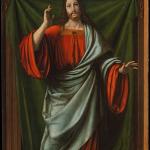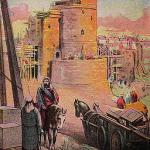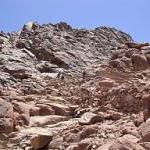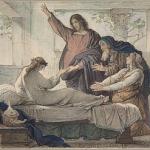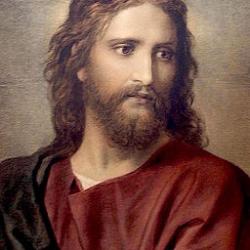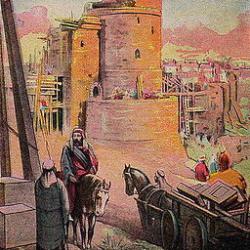
“He would have walked right here,” I tell those with me. I’ve been blessed to introduce groups of people to the Holy Land. Some came specifically “to walk where Jesus walked.” At these sacred places, I love teaching them about what happened and still happens there. I‘m glad to walk with groups of students or church leaders to places where walking took Jesus to heal and teach individuals with needs and faith. But regardless of where we are, we can in our hearts and minds walk with Jesus.
Christ’s “Home Town”
After being rejected in Nazareth, Jesus went to live in Capernaum; I sometimes call it His home town. Teaching there, I give those with me some private time to think and pray.
Noticing Needs
In his talk “Walk With Me,” President Henry B. Eyring noted, “[Jesus] seemed to take particular notice of people who were overlooked and even shunned by society.” 1 Many of these in Capernaum would have seen Him, known who He was, and observed what He did.
The woman with a 13-year “issue of blood” was too self-conscious to approach Him directly, so she waited in a crowd where He might come, then reached out to touch His robe and was instantly healed. She planned to slip quietly away, but He spoke, calling her “daughter” and acknowledging her faith.
Many people saw and heard this, and many more would learn of it from them. Her experience must have inspired and instructed others in Capernaum, as it inspires us to read about it now.
Giving Freely
Four citizens of Capernaum sought help creatively. They took a paralyzed friend to a building where Jesus was speaking. All space was filled, so they cut away part of the roof and lowered down bed with friend. Jesus healed the man, warning him that he must not return to his sins. Jesus did not reject a suffering man who had been a sinner—nor should we.
Jesus was concerned with people in need, not with wealth or influence. When a centurion asked Him to merely speak to heal his servant, Jesus did so; the servant was healed. When influential Jairus begged Jesus to heal his dying daughter, Jesus raised her.
President Eyring (cited earlier) counseled that we can “know Him best” as we follow His example of service, concluding, “May we each choose to walk with Him and to recognize how He walks with us.”
Jericho Roads
In a city with a vivid history, some people of Jericho made statements in bold, conspicuous ways.
Receiving Sight
Beggars lined roads leading toward Jerusalem, hoping for alms—blind Bartimaeus among them. Learning Jesus was passing by, he cried out loudly, “Jesus, thou Son of David, have mercy on me.” Those around him tried to quiet him, but he kept yelling, “Thou Son of David, have mercy on me!”
Jesus heard him, as did everyone reasonably close, and asked that he be brought to Him. Bartimaeus, “casting away his garment” (which might have attracted even more attention), came forward. Jesus asked, “What wilt thou that I should do unto thee?” “Lord, that I might receive my sight” was answered by “Go thy way; thy faith hath made thee whole” (Mark 10:46-52).
Bartimaeus received more than physical sight: he became a disciple, joined the Church, and followed the covenant path.
Climbing a Tree
At another time in Jericho, a chief tax collector, a very short man named Zacchaeus, was determined to see Jesus. Short people don’t see well through crowds, so Zacchaeus climbed a large tree. Though despised as a tax collector (and thus “a sinner”), Zacchaeus was giving freely to the poor and living an honest and moral life.
Knowing his heart, Jesus saw him and called out, “Zacchaeus, make haste, and come down; for today I must abide at thy house.” Jesus added, “This day is salvation come to this house.” Jesus looked both down and up to find those who needed Him. Do we?
Sacred Sites in Jerusalem
Elder Ulisses Soares assured us, “There is no greater, more thrilling, and more soul-ennobling challenge than learning how to walk with the Lord and simultaneously receiving the magnificent blessing of having Him walk with us.” 2
True healing vs. superstition
In the Pool of Bethesda, sacrificial lambs were washed, and a tradition claimed that an angel would periodically stir the water and the first infirm person to enter it would be healed. An impotent man had been waiting 38 years, but others were always faster. Jesus healed him instantly (John 5: 2-9).
Jesus taught this man, and all who then saw or now walk with Him, that a person’s heart and life state, along with their faith, enable healing, not superstitions about sacrifice water.
At the Temple
As Jesus entered Jerusalem triumphantly, a large excited crowd chose to walk with Him, crying out hosannas and casting palm branches in His path. Children sang all the way into the temple, and He continued healing there.
Returning during the week, He taught of the first and second great commandments and the striking lesson of the widow’s mite. Showing my visitors the temple steps, I point out that the stairs alternate being short and long so that temple worshippers have to slow down and be more thoughtful or reverent entering this sacred place.
But Jesus knew that all was not thoughtful and reverent. Men seeking to destroy Jesus tried to stop the singing and the healing (though sacred singing and healing couldn’t be stopped by their evil). Jesus knew what was to happen, and He blessed those who continued to walk with Him—even until the end.
We could not join in shouting hosannas or spreading branches, and we could not hear His words in the temple. But we can walk with Him in our hearts as we learn of the joys and unfathomable suffering of His life. We may not touch His robe, beg by the roadside, climb trees, or meet Him at Bethesda, but we know that as we learn of Him we can walk with Him in our gratitude. He will accept us and help us on this journey.



